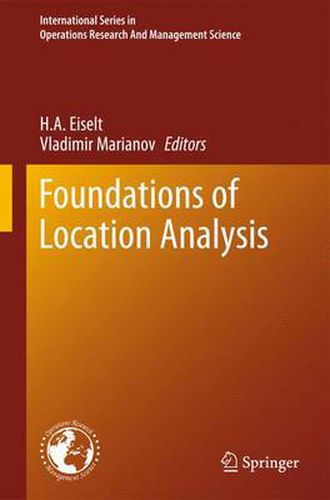Readings Newsletter
Become a Readings Member to make your shopping experience even easier.
Sign in or sign up for free!
You’re not far away from qualifying for FREE standard shipping within Australia
You’ve qualified for FREE standard shipping within Australia
The cart is loading…






This title is printed to order. This book may have been self-published. If so, we cannot guarantee the quality of the content. In the main most books will have gone through the editing process however some may not. We therefore suggest that you be aware of this before ordering this book. If in doubt check either the author or publisher’s details as we are unable to accept any returns unless they are faulty. Please contact us if you have any questions.
Location analysis has matured from an area of theoretical inquiry that was designed to explain observed phenomena to a vibrant field which can be and has been used to locate items as diverse as landfills, fast food outlets, gas stations, as well as politicians and products in issue and feature spaces. Modern location science is dealt with by a diverse group of researchers and practitioners in geography, economics, operations research, industrial engineering, and computer science.
Given the tremendous advances location science has seen from its humble beginnings, it is time to look back. The contributions in this volume were written by eminent experts in the field, each surveying the original contributions that created the field, and then providing an up-to-date review of the latest contributions.
Specific areas that are covered in this volume include:
* The three main fields of inquiry: minisum and minimax problems and covering models * Nonstandard location models, including those with competitive components, models that locate undesirable facilities, models with probabilistic features, and problems that allow interactions between facilities * Descriptions and detailed examinations of exact techniques including the famed Weiszfeld method, and heuristic methods ranging from Lagrangean techniques to Greedy algorithms * A look at the spheres of influence that the facilities generate and that attract customers to them, a topic crucial in planning retail facilities * The theory of central places, which, other than in mathematical games, where location science was born
$9.00 standard shipping within Australia
FREE standard shipping within Australia for orders over $100.00
Express & International shipping calculated at checkout
This title is printed to order. This book may have been self-published. If so, we cannot guarantee the quality of the content. In the main most books will have gone through the editing process however some may not. We therefore suggest that you be aware of this before ordering this book. If in doubt check either the author or publisher’s details as we are unable to accept any returns unless they are faulty. Please contact us if you have any questions.
Location analysis has matured from an area of theoretical inquiry that was designed to explain observed phenomena to a vibrant field which can be and has been used to locate items as diverse as landfills, fast food outlets, gas stations, as well as politicians and products in issue and feature spaces. Modern location science is dealt with by a diverse group of researchers and practitioners in geography, economics, operations research, industrial engineering, and computer science.
Given the tremendous advances location science has seen from its humble beginnings, it is time to look back. The contributions in this volume were written by eminent experts in the field, each surveying the original contributions that created the field, and then providing an up-to-date review of the latest contributions.
Specific areas that are covered in this volume include:
* The three main fields of inquiry: minisum and minimax problems and covering models * Nonstandard location models, including those with competitive components, models that locate undesirable facilities, models with probabilistic features, and problems that allow interactions between facilities * Descriptions and detailed examinations of exact techniques including the famed Weiszfeld method, and heuristic methods ranging from Lagrangean techniques to Greedy algorithms * A look at the spheres of influence that the facilities generate and that attract customers to them, a topic crucial in planning retail facilities * The theory of central places, which, other than in mathematical games, where location science was born